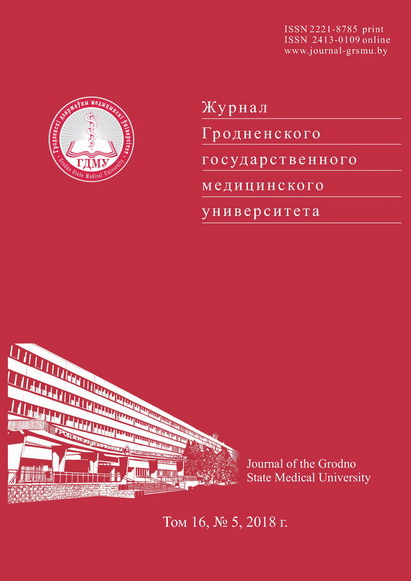СИНДРОМ УДЛИНЕННОГО ИНТЕРВАЛА QT. ЧАСТЬ 2
Аннотация
Синдром удлиненного интервала QT (LQTS) – это потенциально жизнеугрожающая каналопатия, сопровождающаяся удлинением интервала QT на 12-канальной ЭКГ, синкопальными состояниями и высоким риском внезапной сердечной смерти вследствие развития полиморфной желудочковой тахикардии типа torsade de pointes. Первоочередной целью в ведении пациентов с LQTS на современном этапе является недопущение недиагностированных его форм, адекватное лечение и профилактика, чему способствует быстрое развитие молекулярной биологии и генетики. Во второй части настоящего обзора отражены основные достижения в диагностике и лечении синдрома удлиненного интервала QT.
Литература
Priori SG, Wilde AA, Horie M, Cho Y, Behr ER, Berul C, Blom N, Brugada J, Chiang CE, Huikuri H, Kannankeril P, Krahn A, Leenhardt A, Moss A, Schwartz PJ, Shimizu W, Tomaselli G, Tracy C. HRS/EHRA/APHRS expert consensus statement on the diagnosis and management of patients with inherited primary arrhythmia syndromes. Heart Rhythm. 2013;10(12):1932-1963. doi: 10.1016/j.hrthm.2013.05.014.
Priori SG, Schwartz PJ, Napolitano C, Bloise R, Ronchetti E, Grillo M, Vicentini A, Spazzolini C, Nastoli J, Bottelli G, Folli R, Cappelletti D. Risk stratification in the long-QT syndrome. N. Engl. J. Med. 2003;348(19):1866-1874. doi: 10.1056/NEJMoa022147.
Priori SG, Blomström-Lundqvist C, Mazzanti A, Blom N, Borggrefe M, Camm J, Elliott PM, Fitzsimons D, Hatala R, Hindricks G, Kirchhof P, Kjeldsen K, Kuck KH, Hernandez-Madrid A, Nikolaou N, Norekvål TM, Spaulding C, Van Veldhuisen DJ; ESC Scientific Document Group. 2015 ESC Guidelines for the management of patients with ventricular arrhythmias and the prevention of sudden cardiac death: The Task Force for the Management of Patients with Ventricular Arrhythmias and the Prevention of Sudden Cardiac Death of the European Society of Cardiology (ESC). [Internet]. Eur. Heart. J. 2015;36(41):2793-2867. URL: https://doi: 10.1093/eurheartj/ehv316.
Lepeschkin E, Surawitz B. The measurement of the Q-T interval of the electrocardiogram. Circulation. 1952;6(3):378-388.
Couderc JP, Zareba W. T-Wave Morphology in LQTS Patients: Challenges and Hopes. JACC. Clin. Electrophysiol. 2017;3(4):382-383. doi: 10.1016/j.jacep.2016.12.019.
Porta-Sánchez A, Spillane DR, Harris L, Xue J, Dorsey P, Care M, Chauhan V, Gollob MH, Spears DA . T-Wave Morphology Analysis in Congenital Long QT Syndrome Discriminates Patients From Healthy Individuals. JACC. Clin. Electrophysiol. 2017;3(4):374-381. doi: 10.1016/j.jacep.2016.10.013.
Isserman RS, Simpao AF, Schwartz AJ, Pearsall MF. T-wave Alternans and Long QT Syndrome. Anesthesiology. 2017;127(3):567. doi: 10.1097/ALN.0000000000001618.
Takasugi N, Goto H, Takasugi M, Verrier RL, Kuwahara T, Kubota T, Toyoshi H, Nakashima T, Kawasaki M, Nishigaki K, Minatoguchi S. Prevalence of Microvolt T-Wave Alternans in Patients With Long QT Syndrome and Its Association With Torsade de Pointes. Circ. Arrhythm. Electrophysiol. 2016;9(2):e003206. doi: 10.1161/CIRCEP.115.003206.
Lupoglazoff JM, Denjoy I, Villain E, Fressart V, Simon F, Bozio A, Berthet M, Benammar N, Hainque B, Guicheney P. Long QT syndrome in neonates: conduction disorders associated with HERG mutations and sinus bradycardia with KCNQ1 mutations. J. Am. Coll. Cardiol. 2004;43(5):826-830. doi: 10.1016/j.jacc.2003.09.049.
Schwartz PJ, Priori SG, Spazzolini C, Moss AJ, Vincent GM, Napolitano C, Denjoy I, Guicheney P, Breithardt G, Keating MT, Towbin JA, Beggs AH, Brink P, Wilde AA, Toivonen L, Zareba W, Robinson JL, Timothy KW, Corfield V, Wattanasirichaigoon D, Corbett C, Haverkamp W, Schulze-Bahr E, Lehmann MH, Schwartz K, Coumel P, Bloise R. Genotype-phenotype correlation in the long-QT syndrome: gene-specific triggers for life-threatening arrhythmias. Circulation. 2001;103(1):89-95.
Clur SA, Chockalingam P, Filippini LH, Widyanti AP, Van Cruijsen M, Blom NA, Alders M, Hofman N, Wilde AA. The Role of the Epinephrine Test in the Diagnosis and Management of Children Suspected of Having Congenital Long QT Syndrome. Pediatr. Cardiol. 2010;31(4):462-468. doi: 10.1007/s00246-009-9603-2.
Viskin S, Rosso R, Rogowski O, Belhassen B, Levitas A, Wagshal A, Katz A, Fourey D, Zeltser D, Oliva A, Pollevick GD, Antzelevitch C, Rozovski U. Provocation of sudden heart rate oscillation with adenosine exposes abnormal QT responses in patients with long QT syndrome: a bedside test for diagnosing long QT syndrome. Eur. Heart J. 2006;27(4):469-475. doi: 10.1093/eurheartj/ehi460.
Schwartz PJ, Priori SG, Locati EH, Napolitano C, Cantù F, Towbin JA, Keating MT, Hammoude H, Brown AM, Chen LS, Colatsky TJ. Long QT syndrome patients with mutations of the SCN5A and HERG genes have differential responses to Na+ channel blockade and to increases in heart rate. Implications for gene-specific therapy. Circulation. 1995;92(12):3381-3386.
Fujimoto Y, Matsumoto T, Honda N, Tojo R, Furuya M, Kasai K, Saito S, Mochimaru F, Ishikawa Y. Prenatal diagnosis of long QT syndrome by non-invasive fetal electrocardiography. J. Obstet. Gynaecol. Res. 2009;35(3):555-561. doi: 10.1111/j.1447-0756.2008.00982.x.
Schwartz PJ. Idiopathic long QT syndrome: progress and questions. Am. Heart J. 1985;109(2):399-411.
Chockalingam P, Crotti L, Girardengo G, Johnson JN, Harris KM, van der Heijden JF, Hauer RN, Beckmann BM, Spazzolini C, Rordorf R, Rydberg A, Clur SA, Fischer M, van den Heuvel F, Kääb S, Blom NA, Ackerman MJ, Schwartz PJ, Wilde AA. Not all beta-blockers are equal in the management of long QT syndrome types 1 and 2: higher recurrence of events under metoprolol. J. Am. Coll. Cardiol. 2012;60(20):2092-2099. doi: 10.1016/j.jacc.2012.07.046.
Abu-Zeitone A, Peterson DR, Polonsky B, McNitt S, Moss AJ. Efficacy of different beta-blockers in the treatment of long QT syndrome. J. Am. Coll. Cardiol. 2014;64(13):1352-1358. doi: 10.1016/j.jacc.2014.05.068.
Ackerman MJ, Priori SG, Dubin AM, Kowey P, Linker NJ, Slotwiner D, Triedman J, Van Hare GF, Gold MR. Beta-blocker therapy for long QT syndrome and catecholaminergic polymorphic ventricular tachycardia: Are all beta-blockers equivalent? Heart Rhythm. 2017;14(1):e41-e44. doi: 10.1016/j.hrthm.2016.09.012.
Mazzanti A, Maragna R, Faragli A, Monteforte N, Bloise R, Memmi M, Novelli V, Baiardi P, Bagnardi V, Etheridge SP, Napolitano C, Priori SG. Gene-Specific Therapy With Mexiletine Reduces Arrhythmic Events in Patients With Long QT Syndrome Type 3. J. Am. Coll. Cardiol. 2016;67(9):1053-1058. doi: 10.1016/j.jacc.2015.12.033.
Badri M, Patel A, Patel C, Goldstein M, Robinson VM, Xue X, Yang L, Kowey PR, Yan GX. Mexiletine Prevents Recurrent Torsades de Pointes in Acquired Long QT Syndrome Refractory to Conventional. JACC. Clin. Electrophysiology. 2015;1(4):315-322. doi: 10.1016/j.jacep.2015.05.008.
Moss AJ, Windle JR, Hall WJ, Zareba W, Robinson JL, McNitt S, Severski P, Rosero S, Daubert JP, Qi M, Cieciorka M, Manalan AS. Safety and efficacy of flecainide in subjects with Long QT-3 syndrome (DeltaKPQ mutation): a randomized, double-blind, placebo-controlled clinical trial. Ann. Noninvasive Electrocardiol. 2005;10(4 Suppl):59-66. doi: 10.1111/j.1542-474X.2005.00077.x.
Chorin E, Taub R, Medina A, Flint N, Viskin S, Benhorin J. Long-term flecainide therapy in type 3 long QT syndrome. Europace. 2018;20(2):370-376. doi: 10.1093/europace/euw439.
Beinart R, Michailidis A, Gurevitz OT, Glikson M. Is flecainide dangerous in long QT-3 patients? Pacing Clin. Electrophysiol. 2009;32(1):143-145. doi: 10.1111/j.1540-8159.2009.02190.x.
Chorin E, Hu D, Antzelevitch C, Hochstadt A, Belardinelli L, Zeltser D, Viskin S. Ranolazine for Congenital Long QT Syndrome Type III (LQT3): Experimental and Long-Term Clinical Data. Circ. Arrhythm. Electrophysiol. 2016;9(10): e004370. doi: 10.1161/CIRCEP.116.004370.
Schwartz PJ, Spazzolini C, Priori SG, Crotti L, Vicentini A, Landolina M, Gasparini M, Wilde AA, Knops RE, Denjoy I, Toivonen L, Mönnig G, Al-Fayyadh M, Jordaens L, Borggrefe M, Holmgren C, Brugada P, De Roy L, Hohnloser SH, Brink PA. Who are the long-QT syndrome patients who receive an implantable cardioverter-defibrillator and what happens to them? : data from the European Long-QT Syndrome Implantable Cardioverter-Defibrillator (LQTS ICD) Registry. Circulation. 2010;122(13):1272-1282. doi: 10.1161/CIRCULATIONAHA.110.950147.
Olde Nordkamp LR, Postema PG, Knops RE, van Dijk N, Limpens J, Wilde AA, de Groot JR. Implantable cardioverter-defibrillator harm in young patients with inherited arrhythmia syndromes: a systematic review and meta-analysis of inappropriate shocks and complications. Heart Rhythm. 2016;13(2):443-454. doi: 10.1016/j.hrthm.2015.09.010.
Mönnig G, Köbe J, Löher A, Wasmer K, Milberg P, Zellerhoff S, Pott C, Zumhagen S, Radu R, Scheld HH, Haverkamp W, Schulze-Bahr E, Eckardt L. Role of implantable cardioverter defibrillator therapy in patients with acquired long QT syndrome: a long-term follow-up. Europace. 2012;14(3):396-401. doi: 10.1093/europace/eur316.
Hocini M, Pison L, Proclemer A, Larsen TB, Madrid A, Blomström-Lundqvist C; Scientific Initiative Committee, European Heart Rhythm Association. Diagnosis and management of patients with inherited arrhythmia syndromes in Europe: results of the European Heart Rhythm Association Survey. Europace. 2014;16(4):600-603. doi: 10.1093/europace/euu074.
Antonopoulos A, Lawrence D, Patrini D, Scarci M, George R, Hayward M, Mitsos S, Panagiotopoulos N. The role of sympathectomy in long QT syndrome. J. Thorac. Dis. 2017;9(9):3394-3397. doi: 10.21037/jtd.2017.08.45.
Zipes DP, Camm AJ, Borggrefe M, Buxton AE, Chaitman B, Fromer M, Gregoratos G, Klein G, Moss AJ, Myerburg RJ, Priori SG, Quinones MA, Roden DM, Silka MJ, Tracy C, Smith SC Jr, Jacobs AK, Adams CD, Antman EM, Anderson JL, Hunt SA, Halperin JL, Nishimura R, Ornato JP, Page RL, et al.; American College of Cardiology/American Heart Association Task Force; European Society of Cardiology Committee for Practice Guidelines; European Heart Rhythm Association; Heart Rhythm Society. ACC/AHA/ESC 2006 Guidelines for Management of Patients with Ventricular Arrhythmias and the Prevention of Sudden Cardiac Death [Internet]. Circulation. 2006;114(10):e385-484. URL: https://doi: 10.1161/circulationaha.106.178233.
Drake E, Preston R, Douglas J. Brief review: anesthetic implications of long QT syndrome in pregnancy. Can. J. Anaesth. 2007;54(7):561-572. doi: 10.1007/bf03022321.
N. еl-Sherif N, Caref EB, Yin H, Restivo M. The electrophysiological mechanism of ventricular tachyarrhythmias in the long QT syndrome: tridimensional mapping of activation and recovery patterns. Circ Res. 1996;79(3):474-492.






























